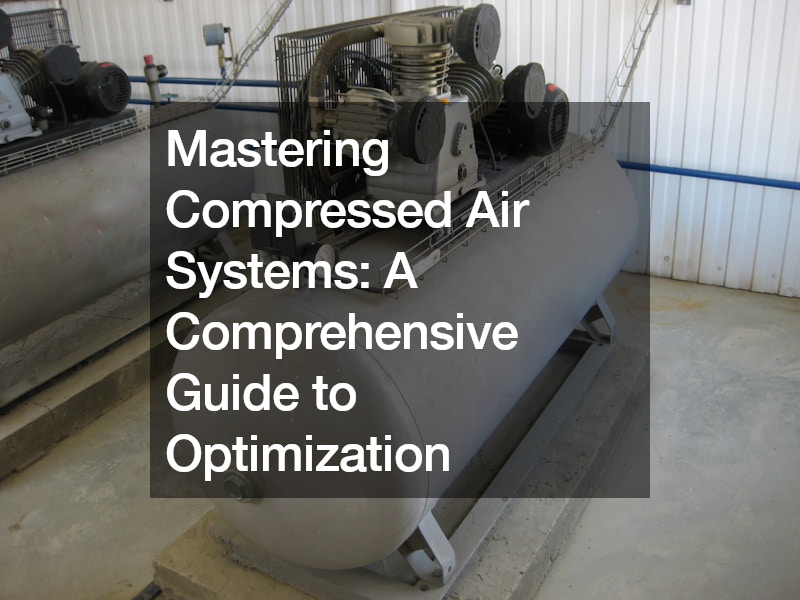Compressed air systems are the lifeline of numerous industrial and commercial operations, powering essential machinery and tools across various sectors. To ensure optimal performance and efficiency, it is crucial to have a deep understanding of the components and operations of these systems. This comprehensive guide will delve into the critical aspects of mastering compressed air systems, offering insights and strategies to optimize performance and reduce energy consumption.
Understanding Compressed Air Systems
A compressed air system comprises several key components, including compressors, dryers, filters, and air tanks. Each component plays a vital role in delivering clean, dry, and reliable compressed air to the production site.
Compressors serve as the heart of the system, pressurizing atmospheric air to the required level, while dryers and filters ensure the removal of moisture and contaminants to maintain air quality.
Types of Compressors
Compressors are available in various types, including positive displacement (reciprocating, rotary) and dynamic (centrifugal). Among these, screw compressors are widely preferred for their efficiency and reliability. These compressors are commonly used in industrial applications, offering consistent performance and energy savings. Organizations can source high-quality screw compressors from reputable air solutions providers like GTEC, ensuring reliable and efficient compressed air supply.
Energy Efficiency of Compressors
Energy efficiency is a critical consideration in compressor operations. Variable-speed drive (VSD) compressors, such as those offered by GTEC, deliver significant energy savings compared to fixed-speed compressors. By adjusting their speed according to demand, VSD compressors minimize energy wastage and contribute to cost reduction. GTEC’s VSD compressors are designed to deliver optimal performance while maximizing energy efficiency, helping businesses achieve their sustainability goals.
Dryers and Filters
Effective moisture and contaminant removal are essential for maintaining air quality and system reliability. Dryers, including desiccant and refrigerant types, play a vital role in removing moisture from compressed air, while filters ensure the removal of contaminants such as dust and particles. Organizations can rely on GTEC for a comprehensive range of dryers and filters to meet specific application requirements, ensuring clean and dry compressed air for optimal system performance.
Air Tanks
Air tanks, also known as air receivers, act as buffers in compressed air systems, stabilizing pressure fluctuations and improving overall system efficiency. Proper sizing and installation of air tanks are crucial to ensure stable pressure delivery and minimize system downtime. Organizations can leverage GTEC’s expertise in selecting and sizing air tanks to meet the unique needs of their applications, ensuring reliable and efficient compressed air supply.
Optimization Strategies
In addition to selecting the right components, implementing optimization strategies is essential for maximizing the performance and efficiency of compressed air systems. Regular maintenance and servicing, along with the adoption of energy-efficient practices, can significantly reduce energy consumption and operating costs. GTEC offers comprehensive maintenance services and energy audits to help organizations identify opportunities for improvement and achieve their optimization goals.
Applications of Compressed Air Systems
Compressed air systems find a wide range of applications across various industries due to their versatility, reliability, and efficiency. Here are some common applications where compressed air systems play a crucial role:
Manufacturing:
In manufacturing facilities, compressed air is used to power pneumatic tools and equipment such as drills, grinders, nail guns, and impact wrenches. These tools provide high torque and precision, making them ideal for assembly lines, metalworking, woodworking, and other production processes. Compressed air is often used for material handling, such as conveying bulk materials through pipelines or powering pneumatic actuators for machinery automation.
Automotive Industry:
The automotive industry extensively relies on compressed air for various applications, including painting, sanding, and cleaning operations. Compressed air is used to power paint sprayers for applying coatings to vehicle bodies and pneumatic sanders for smoothing surfaces during refinishing processes. Additionally, compressed air is essential for operating pneumatic lifts, tire inflation systems, and pneumatic tools in automotive repair and maintenance workshops.
Food and Beverage Processing:
Compressed air is widely utilized in the food and beverage industry for packaging, bottling, and processing applications. It is commonly used to operate pneumatic valves, actuators, and conveyors in production lines for filling, sealing, and labeling containers. Compressed air is also employed for cleaning and sterilizing equipment, as well as for generating inert atmospheres in food packaging to extend shelf life and prevent spoilage.
Construction and Infrastructure:
Construction sites utilize compressed air for various tasks, including powering jackhammers, pneumatic drills, and concrete vibrators. Compressed air is also used for sandblasting surfaces to remove rust, paint, and debris from metal structures and concrete surfaces. In addition, pneumatic tools such as air-powered nail guns and staple guns are commonly used in carpentry, framing, and roofing applications.
Medical and Healthcare:
Compressed air plays a critical role in medical and healthcare facilities for various applications, including respiratory therapy, surgical tools, and laboratory equipment. Medical air compressors provide a clean and reliable source of compressed air for operating ventilators, anesthesia machines, and dental tools. Compressed air also powers pneumatic actuators and instruments in surgical procedures and diagnostic testing.
Energy Production:
Compressed air energy storage (CAES) systems are utilized in the energy sector to store surplus energy generated during periods of low demand. Compressed air is stored in underground caverns or pressurized vessels and released to drive turbines and generate electricity during peak demand. CAES systems provide a cost-effective and efficient method for balancing grid supply and demand, supporting renewable energy integration and grid stability.
These are just a few examples of the diverse applications of compressed air systems across different industries. Compatible air systems’ versatility and reliability continue to play a vital role in powering essential processes and operations worldwide.
Conclusion
Mastering compressed air systems is vital for maximizing productivity, efficiency, and cost-effectiveness in industrial and commercial operations. With a thorough understanding of system components and optimization strategies, businesses can achieve significant improvements in performance while minimizing energy consumption and operating costs. By partnering with trusted air solutions providers like GTEC, organizations can access innovative solutions and expert guidance to ensure the reliability and efficiency of their compressed air systems for years to come.
.


